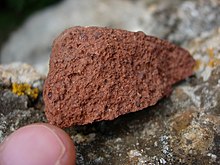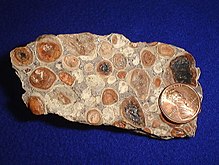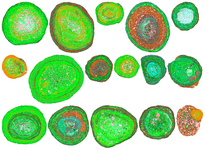
Back Bauxiet Afrikaans بوكسيت Arabic Bauxita AST Boksit Azerbaijani Баксіт Byelorussian Боксит Bulgarian বক্সাইট Bengali/Bangla Boksit BS Bauxita Catalan Bauxit Czech



Bauxite (/ˈbɔːksaɪt/) is a sedimentary rock with a relatively high aluminium content. It is the world's main source of aluminium and gallium. Bauxite consists mostly of the aluminium minerals gibbsite (Al(OH)3), boehmite (γ-AlO(OH)) and diaspore (α-AlO(OH)), mixed with the two iron oxides goethite (FeO(OH)) and haematite (Fe2O3), the aluminium clay mineral kaolinite (Al2Si2O5(OH)4) and small amounts of anatase (TiO2) and ilmenite (FeTiO3 or FeO·TiO2).[1][2] Bauxite appears dull in luster and is reddish-brown, white, or tan.[3]
In 1821, the French geologist Pierre Berthier discovered bauxite near the village of Les Baux in Provence, southern France.[4][5]
Bauxite extraction and refining has numerous negative consequences to the environment and to people. The negative impacts are well document and there are many examples from all over the world. These impacts include the destruction of the environment, water, and air soil pollution and soil degradation.[6][7]
- ^ Geological Survey (U.S.) (1986). Geological Survey Professional Paper. Geological Survey Professional Paper. U.S. Government Printing Office. p. 2-PA20.
- ^ "The Clay Minerals Society Glossary for Clay Science Project". Archived from the original on 2016-04-16.
- ^ "Aluminum". Minerals Education Coalition.
- ^ P. Berthier (1821) "Analyse de l'alumine hydratée des Beaux, département des Bouches-du-Rhóne" (Analysis of hydrated alumina from Les Beaux, department of the Mouths-of-the-Rhone), Annales des mines, 1st series, 6 : 531-534. Notes:
- In 1847, in the cumulative index of volume 3 of his series, Traité de minéralogie, French mineralogist Armand Dufrénoy listed the hydrated alumina from Les Beaux as "beauxite". (See: A. Dufrénoy, Traité de minéralogie, volume 3 (Paris, France: Carilian-Goeury et Vor Dalmont, 1847), p. 799.)
- In 1861, H. Sainte-Claire Deville credits Berthier with naming "bauxite", on p. 309, "Chapitre 1. Minerais alumineux ou bauxite" of: H. Sainte-Claire Deville (1861) "De la présence du vanadium dans un minerai alumineux du midi de la France. Études analytiques sur les matières alumineuses." (On the presence of vanadium in an alumina mineral from the Midi of France. Analytical studies of aluminous substances.), Annales de Chimie et de Physique, 3rd series, 61 : 309-342.
- ^ Burgess, N. (October 26, 2015). "March 23, 1821: Bauxite Discovered". Earth. Retrieved 2021-07-31.
- ^ Ky, Lee; Ly, Ho; Kh, Tan; Yy, Tham; Sp, Ling; Am, Qureshi; T, Ponnudurai; R, Nordin (2017-12-01). "Environmental and Occupational Health Impact of Bauxite Mining in Malaysia: A Review". IIUM Medical Journal Malaysia. 16 (2). doi:10.31436/imjm.v16i2.346. ISSN 2735-2285.
- ^ Dibattista, Ilaria; Camara, Abdoul Rachid; Molderez, Ingrid; Benassai, Edoardo Maria; Palozza, Francesco (2023). "Socio-environmental impact of mining activities in Guinea: The case of bauxite extraction in the region of Boké". Journal of Cleaner Production. 387: 135720. doi:10.1016/j.jclepro.2022.135720.
© MMXXIII Rich X Search. We shall prevail. All rights reserved. Rich X Search